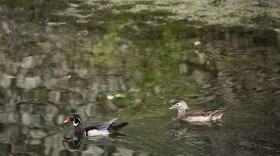One of the first things people noticed were the birds.
Once the stay-at-home orders were in place and the sounds of traffic and business dimmed, the birds seemed louder. There seemed to be more of them.
It’s not clear if birds have really raised their volume (more on that in a bit), but there are more in Texas these days. The state is in the middle of peak bird migration, a two-week period when around a billion birds fly through. And, scientists say, this year will provide a unique natural experiment to see what happens to that migration when it passes over a land less abuzz with human activity.
“There are some really interesting questions along the lines of, 'What if you had the opportunity to take away people from this place?’" says Andrew Farnsworth a research associate at the Cornell Lab of Ornithology, who specializes in bird migration. “Now there's some chances to think about it – if people are smart about the way they ask the questions.”
One question is: Are the birds really getting louder?
Farnsworth's answer: Maybe. Maybe not.
He says it's possible that people are just noticing birds more because their song is not masked by other sounds. But “it could actually be that birds are louder, because they've returned to some sort of pre-industrial sort of amplitude.”
Birds may also be singing in different frequencies or pitches as the need to compete with manmade sounds decreases.
While most people in cities and towns have noticed a reduction in noise pollution, light pollution may have changed as well. That could be good news for the birds as they, like insects, are easily distracted by lights.
“When that happens, they’re vulnerable to collisions with buildings around them or even just … exhausted and confused,” says Julia Wang, a project leader with the Cornell Lab’s “Lights Out” Program. They then can become “vulnerable to other urban threats like cats or toxins.”
But, as with their songs, Farnsworth says, it’s impossible to know right now whether the change in light sources could be influencing bird behavior.
“You could probably argue that there will be less of [energy] output because there are fewer people in the cities, but obviously more people are at home,” he says.
Like buildings, cars and trucks also kill vast numbers of birds every year. So fewer of them on the road would suggest higher bird survival rates during migration and beyond. Farnsworth says decreased air pollution from a drop in energy use may also be interesting topics for ornithologists.
Some of these subjects can be studied remotely, by looking at satellite imagery and comparing it to previous years. But, unfortunately for researchers, the very situation that presented such an intriguing natural experiment is also keeping many of them from the field.
“A lot of the research that we’ve been planning is temporarily on hold because of coronavirus," says Wang, who hopes to expand bird “collision monitoring” programs in Texas after pandemic restrictions are lifted.
Got a tip? Email Mose Buchele at mbuchele@kut.org. Follow him on Twitter @mosebuchele.
If you found the reporting above valuable, please consider making a donation to support it. Your gift pays for everything you find on KUT.org. Thanks for donating today.






